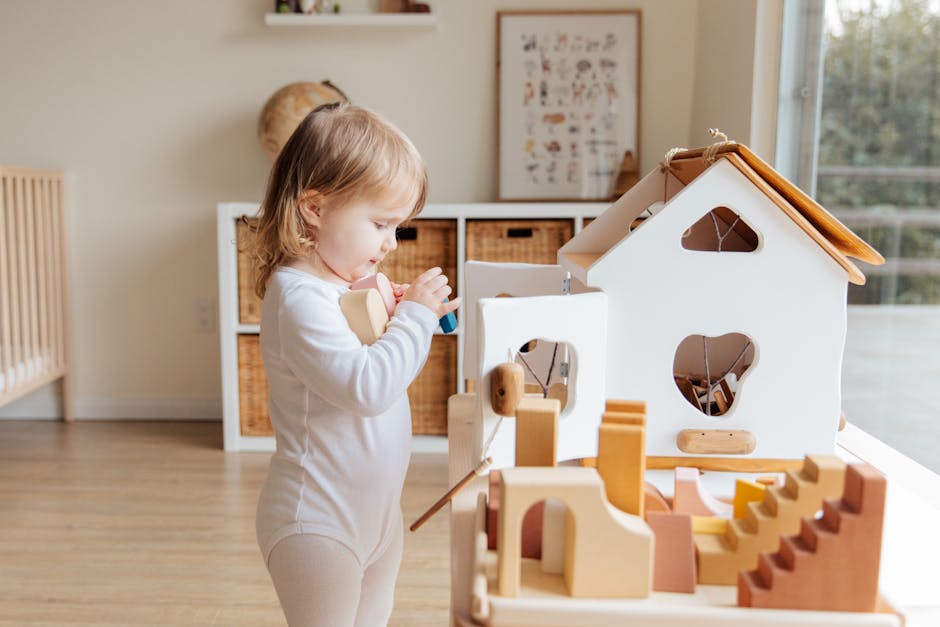Why Early Detection Matters
Understanding the impact of early identification can make a significant difference in a child’s development. Many parents hear terms like “developmental delay” but aren’t sure what it truly means or what they should do next. Here’s what you need to know.
What is a Developmental Delay?
A developmental delay occurs when a child doesn’t reach developmental milestones at the expected times. This can affect various areas, such as:
- Speech and language: Trouble expressing needs or understanding others
- Motor skills: Difficulty with crawling, walking, or using hands
- Cognitive skills: Challenges with problem-solving or following instructions
- Social-emotional skills: Struggles with interacting with others or self-regulation
It’s important to remember: a delay doesn’t always mean a lifelong issue—it may simply signal that a child needs support to catch up.
The Critical Window: Early Childhood
From birth to age five, the brain forms more than one million new neural connections every second. This rapid growth period is often called the “critical window” because it’s when children are most responsive to interventions and experiences that shape their development.
Early detection during this time makes it easier to:
- Support skill-building at a faster pace
- Address specific needs before they escalate
- Reduce potential learning gaps later in childhood
Long-Term Benefits of Early Intervention
Intervening early not only helps children in the short term but also lays a foundation for their future success. Some of the long-term benefits include:
- Social: Improved ability to form relationships and express feelings
- Emotional: Greater self-esteem and emotional regulation
- Cognitive: Better problem-solving, memory, and learning skills
Research shows that children who receive support early are more likely to thrive in school, develop independence, and build healthier relationships into adulthood.
Recognizing challenges isn’t about labeling your child—it’s about empowering them with the right tools at the right time.
Spotting the Early Warning Signs
The early years move fast. One minute it’s tummy time, the next you’re staring down preschool applications. But amid the changes, certain developmental milestones help track if a child’s growth is on course—or might need closer attention.
From birth to five, kids typically learn to smile, babble, sit, walk, speak, play with others, and begin some form of emotional self-regulation. These milestones unfold at different paces for each child, but general timelines exist.
By six months, expect eye contact, turning toward sounds, and some simple vocalizations. By one year, a child may be standing with support, using basic gestures, and saying a few words. By two, many kids string words into simple phrases and follow basic instructions. Age three brings more interactive play, sentences with 4–5 words, and physical skills like climbing. By five, children can often tell stories, draw basic shapes, hop on one foot, and show a clearer sense of empathy.
Still, development isn’t a checklist—it’s a pattern. What matters is progress across communication, motor skills, social interaction, and behavior. Warning signs include limited eye contact, no pointing or waving by 12 months, not walking by 18 months, delayed speech, or trouble engaging with peers.
“Wait and see” can sometimes be reasonable—but it’s also often used when something more proactive is needed. The difference usually comes down to how wide the developmental gap is—and whether the delay is getting better, worse, or staying the same.
Many parents share stories that sound familiar: the toddler who lined up toys obsessively and rarely spoke, or the baby who hit all physical milestones on time but didn’t respond to their name. These real-life patterns often surface first at home, not the doctor’s office. Trust those instincts. You see your child more than anyone else does.
Early attention doesn’t mean rushing to diagnose—it means watching with intention. And acting early if the signs persist.
What Causes Developmental Delays?
Developmental delays don’t come from one simple source. Often, they result from a web of contributing factors. Some are genetic—certain conditions and syndromes can affect how a child develops from day one. Others stem from complications during pregnancy or birth, such as low oxygen levels or premature delivery. And then there are environmental triggers—chronic stress, exposure to toxins, or a lack of stimulation—all of which can impact how a child learns and grows.
But here’s the truth: this isn’t about blame. It’s about understanding. Most delays aren’t caused by something a parent did—or didn’t—do. Assigning guilt is not only unhelpful, it gets in the way of what really matters: moving forward with the right kind of support.
No two children with developmental delays look exactly the same. One child might speak late but move with ease. Another could be physically advanced but struggle to connect socially. That’s why personalizing care, staying observant, and trusting your gut as a parent is critical.
Understanding the “why” behind a delay is helpful—but acting on it is what changes the game.
The Role of Pediatric Evaluations
When there’s a concern about a child’s development, pediatric evaluations are the next step. These aren’t one-size-fits-all checklists. They’re layered assessments that might include direct observation, parent interviews, and standardized testing. Think structured play, language tasks, and motor skill challenges—all designed to see how a child interacts, moves, and communicates compared to typical developmental benchmarks.
Doctors usually start with a general developmental screening during regular checkups. If something seems off, they may refer families to specialists—a developmental pediatrician, speech-language pathologist, occupational therapist, or child psychologist. These pros dig deeper using tools that gauge things like language comprehension, fine motor coordination, and social-emotional responses.
But here’s the thing: these evaluations aren’t flawless. Sometimes doctors miss subtleties or brush concerns aside. If your gut says something isn’t right—and especially if your child seems to stall or regress—it’s okay to push for a second opinion. No one knows your child better than you do. Trust that instinct.
A proper assessment is about clarity, not labels. It helps you understand your child’s unique pace and, if need be, gives you a head start on building the right support. Early info leads to smarter actions—plain and simple.
Taking Action: Where Parents Should Start
Stepping into the world of developmental support can feel like entering a maze. The first step: build your team. Think of it as assembling a crew, not just checking boxes. Your pediatrician is your anchor. From there, loop in specialists—speech therapists, occupational therapists, or special educators—based on your child’s needs. Don’t wait for a clear label or diagnosis. If something feels off, ask questions and get referrals. Early involvement makes a difference.
Next, get familiar with early intervention services. Most regions offer government-backed programs for children under age three. These aren’t just helpful—they’re often free. Services might include therapy at home, playgroups with trained professionals, or developmental roadmaps tailored to your child. If your child is older, your local school district usually becomes the point of contact.
Here’s the catch: systems can be slow. Public programs come with waitlists, forms, and jargon. Be ready to advocate. Consider private routes if you can afford them—but don’t underestimate public resources either. Many families combine both. Persistence pays off.
Bottom line: no one expects you to have all the answers. But you do have to start. Build your team. Learn the lingo. Keep asking. You’re not just navigating a system—you’re clearing the path for your child.
Supporting Your Child at Home
You don’t need a fancy toolkit or a therapy degree to support your child’s development. Small, purposeful actions done daily can create real change. Simple games like rolling a ball back and forth help with coordination. Singing songs, reading stories, and narrating your day support language. Building blocks and puzzles sharpen problem-solving. The key isn’t complexity—it’s consistency.
Routines matter. Not for control, but for rhythm. Breakfast, then playtime; reading before bed. Predictable patterns help children feel secure, and in that security, they grow. When the same activity happens around the same time each day, the brain learns to expect, respond, and stretch.
Tracking progress doesn’t mean spreadsheets. It means noticing what’s changed: Can they now stack three blocks instead of two? Did they try a new word this week? Keep a mental note or jot it in a journal. The point isn’t to measure for success, but to stay aware.
Progress isn’t linear. Some days will feel like breakthroughs. Others, like standstills. That’s normal. Stay patient. Keep showing up. And adjust when you need to. Flexibility matters as much as structure. Growth is a quiet thing; you won’t always see it happening—but it is.
Advocating Without Burnout
Knowing your rights as a parent isn’t optional—it’s survival. You don’t need a law degree, but you do need to understand the basics: your child’s right to access services, your right to request evaluations, and your place at the decision-making table. Schools and providers may be helpful, but they don’t always volunteer what you’re entitled to. Learn the rules. Ask questions. Take notes.
At the same time, it’s not about going in swinging. The most effective advocacy isn’t loud—it’s steady. Listen. Build relationships. Know when to push and when to partner. Collaboration with professionals doesn’t mean giving up control—it means refining your strategy. You’ll get farther with calm persistence than with one-time firepower.
And here’s the part parents forget: you’re not a machine. Showing up for your child requires fuel—sleep, support, space to breathe. Burnout helps no one. Protect your energy so you can stay in it for the long haul. Regular breaks, honest conversations, people who get it—those aren’t luxuries. They’re essentials. You can’t pour from an empty cup, and your child needs more than just your presence. They need your strength.
More Resources for Parents
You don’t have to navigate developmental delays alone. Plenty of local and online communities exist to help parents find solid ground and shared experience. Whether it’s a neighborhood support group, a Facebook community, or Reddit thread, connecting with parents who’ve been there matters. They offer perspective. They offer support. Sometimes, they offer the exact tip you didn’t know you needed.
Beyond community, there are educational tools built with parents in mind—courses, webinars, and hands-on guides that simplify the science and give straight-up tactics you can use at home. Many early intervention centers also offer free workshops or consultations.
For a well-organized hub of programs, tools, and parent-led insight, check out Mom Smart Hub. One scroll gives you quick access to vetted resources—so you can focus more on your child and less on Googling everything alone.
Final Thoughts
There’s no shame in a developmental delay. It’s not a failure or a reflection of your parenting—it’s simply a signpost. One that says, pay attention here.
Every child follows their own timeline. Some talk late but think fast. Some struggle with buttons but thrive with books. Your job isn’t to compare—it’s to notice, support, and step in when needed.
The good news? Early action works. Kids who get help early build stronger foundations—emotionally, socially, and academically. Whether the path includes speech therapy, occupational support, or simply more engaged play at home, the earlier those tools are brought in, the better the long-term outcome.
Trust your instincts. Stay curious. Keep showing up.
Because awareness sparks growth. And growth—not perfection—is the real win.


